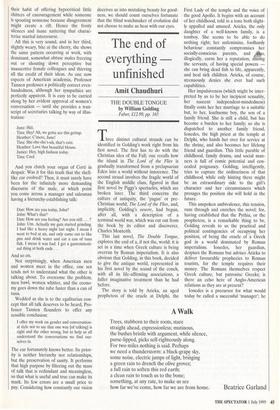The ears have it
Andro Linklater
TALKING FROM 9 TO 5: HOW WOMEN'S AND MEN'S CONVERSATIONAL STYLES AFFECTS WHO GETS HEARD, WHO GETS CREDIT AND WHAT GETS DONE AT WORK by Deborah Tannen Virago, f16.99, pp. 368 The eye, which the biologist, Richard Dawkins, persistently cites as the supreme example of evolutionary development, is a distressingly crude piece of plumbing compared to the ear. While almost anyone who has handled a camera can understand the system of lenses and light sensors which enables us to see, the process of hearing the operation of the organ of Corti, the basilar membrane and hair cells, and of some 30,000 nerve ends crammed into a few cubic millimetres of the inner ear remains an enigma to experts who have devoted their lives to its study. And compared to the eye's imprecise distinction of colours and shade across a desperately limited portion of the spectrum, the ear's capacity to record every gradation of sound between the rustle of a feather and the roar of a jet engine at take-off — louder by a factor of 10 to the power 6 — seems almost infinite.
In Professor Deborah Tannen's books on conversational patterns, notably her two bestsellers, You Just Don't Understand and That's Not What I Meant, this masterpiece of adaptive evolution plays the role of silent villain. Of all its qualities the most miraculous is its capacity to disentangle the sounds of speech at a speed which the fastest computer only hears as a continuous buzz and to translate them into discourse and emotion, but the misunderstandings that arise between men and women in everyday talk suggests that the ear often fails to perform as it should.
Professor Tannen's own explanation for this malfunction is that men and women converse for different reasons, and so hear different cues. Men talk to establish hierarchy,• she argues, hence their prefer- ence for driving round in increasingly bad- tempered circles when lost rather than asking for directions which would be tanta- mount to admitting dependence and thus inferiority. By the same token, women talk to establish relationships, which explains their habit of offering hypocritical little chitters of encouragement while someone is spouting nonsense because disagreement might create a rift. Hence the frosty silences and inane nattering that charac- terise marital intercourse.
All this is very sound, and in her third, slightly weary, bite at the cherry, she shows the same pattern occurring at work, with dominant, somewhat obtuse males freezing out or shouting down perceptive but unassertive female colleagues and thieving all the credit of their ideas. As one now expects of American academia, Professor Tannen professes a politically correct even- handedness, although her sympathies are perfectly apparent. It is easy to be carried along by her evident approval of women's conversation — until she provides a tran- script of secretaries talking by way of illus- tration:
June: Hiii.
Tina: Hey! Ah, we gotta see this gettup. Heather: C'mere, June!
Tina: She-she-she's-uh, that's cute. Heather: Love that beautiful blouse. Janice: Hey, high fashion today. Tina: Cool.
And you clutch your organ of Corti in despair. Was it for this trash that the shell- like ear evolved? Then, it must surely have been for the infinitely more demanding discourse of the male, at which point you come across a manager and salesman having a hierarchy-establishing talk:
Dan: How are you today, John?
John: What's that?
Dan: How are you feeling? Are you still ... ? John: Um. Actually my guts started grinding. I had like a heavy night last night. I mean I went to bed at six, and only came out to like piss and drink water and eat a can of tuna fish. I mean it was bad. I get a gastrointesti- nal thing at both ends . . .
And so on.
Not surprisingly, when American men and women meet in the office, one sex tends not to understand what the other is talking about. To overcome the problem, men bawl, women whitter, and the econo- my goes down the tube faster than a can of tuna.
Wedded as she is to the egalitarian con- cept that all talk deserves to be heard, Pro- fessor Tannen flounders to offer any sensible conclusion:
I offer my work on gender and conversation- al style not to say that one way [of talking] is right and the other wrong, but to help us all understand the conversations we find our- selves in.
The ear fortunately knows better. Its prior- ity is neither hierarchy nor relationships, but the preservation of sanity. It performs that high purpose by filtering out the mass of talk that is redundant and meaningless, so that what is useful and true can make its mark. Its few errors are a small price to pay. Considering how constantly our vision deceives us into mistaking beauty for good- ness, we should count ourselves fortunate that the blind watchmaker of evolution did not choose to make us hear with our eyes.



































































 Previous page
Previous page